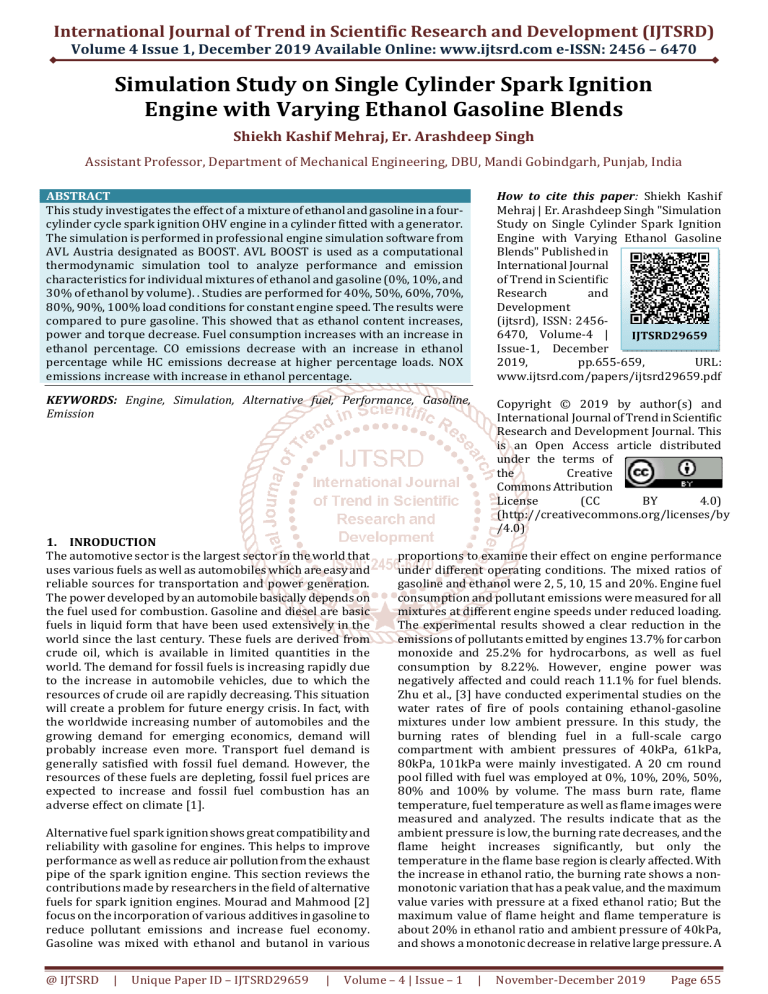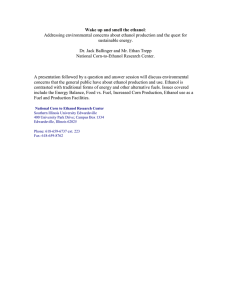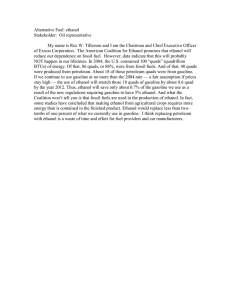
International Journal of Trend in Scientific Research and Development (IJTSRD)
Volume 4 Issue 1, December 2019 Available Online: www.ijtsrd.com e-ISSN: 2456 – 6470
Simulation Study on Single Cylinder Spark Ignition
Engine with Varying Ethanol Gasoline Blends
Shiekh Kashif Mehraj, Er. Arashdeep Singh
Assistant Professor, Department of Mechanical Engineering, DBU, Mandi Gobindgarh, Punjab, India
ABSTRACT
This study investigates the effect of a mixture of ethanol and gasoline in a fourcylinder cycle spark ignition OHV engine in a cylinder fitted with a generator.
The simulation is performed in professional engine simulation software from
AVL Austria designated as BOOST. AVL BOOST is used as a computational
thermodynamic simulation tool to analyze performance and emission
characteristics for individual mixtures of ethanol and gasoline (0%, 10%, and
30% of ethanol by volume). . Studies are performed for 40%, 50%, 60%, 70%,
80%, 90%, 100% load conditions for constant engine speed. The results were
compared to pure gasoline. This showed that as ethanol content increases,
power and torque decrease. Fuel consumption increases with an increase in
ethanol percentage. CO emissions decrease with an increase in ethanol
percentage while HC emissions decrease at higher percentage loads. NOX
emissions increase with increase in ethanol percentage.
How to cite this paper: Shiekh Kashif
Mehraj | Er. Arashdeep Singh "Simulation
Study on Single Cylinder Spark Ignition
Engine with Varying Ethanol Gasoline
Blends" Published in
International Journal
of Trend in Scientific
Research
and
Development
(ijtsrd), ISSN: 24566470, Volume-4 |
IJTSRD29659
Issue-1, December
2019,
pp.655-659,
URL:
www.ijtsrd.com/papers/ijtsrd29659.pdf
KEYWORDS: Engine, Simulation, Alternative fuel, Performance, Gasoline,
Emission
Copyright © 2019 by author(s) and
International Journal of Trend in Scientific
Research and Development Journal. This
is an Open Access article distributed
under the terms of
the
Creative
Commons Attribution
License
(CC
BY
4.0)
(http://creativecommons.org/licenses/by
/4.0)
1. INRODUCTION
The automotive sector is the largest sector in the world that
uses various fuels as well as automobiles which are easy and
reliable sources for transportation and power generation.
The power developed by an automobile basically depends on
the fuel used for combustion. Gasoline and diesel are basic
fuels in liquid form that have been used extensively in the
world since the last century. These fuels are derived from
crude oil, which is available in limited quantities in the
world. The demand for fossil fuels is increasing rapidly due
to the increase in automobile vehicles, due to which the
resources of crude oil are rapidly decreasing. This situation
will create a problem for future energy crisis. In fact, with
the worldwide increasing number of automobiles and the
growing demand for emerging economics, demand will
probably increase even more. Transport fuel demand is
generally satisfied with fossil fuel demand. However, the
resources of these fuels are depleting, fossil fuel prices are
expected to increase and fossil fuel combustion has an
adverse effect on climate [1].
Alternative fuel spark ignition shows great compatibility and
reliability with gasoline for engines. This helps to improve
performance as well as reduce air pollution from the exhaust
pipe of the spark ignition engine. This section reviews the
contributions made by researchers in the field of alternative
fuels for spark ignition engines. Mourad and Mahmood [2]
focus on the incorporation of various additives in gasoline to
reduce pollutant emissions and increase fuel economy.
Gasoline was mixed with ethanol and butanol in various
@ IJTSRD
|
Unique Paper ID – IJTSRD29659
|
proportions to examine their effect on engine performance
under different operating conditions. The mixed ratios of
gasoline and ethanol were 2, 5, 10, 15 and 20%. Engine fuel
consumption and pollutant emissions were measured for all
mixtures at different engine speeds under reduced loading.
The experimental results showed a clear reduction in the
emissions of pollutants emitted by engines 13.7% for carbon
monoxide and 25.2% for hydrocarbons, as well as fuel
consumption by 8.22%. However, engine power was
negatively affected and could reach 11.1% for fuel blends.
Zhu et al., [3] have conducted experimental studies on the
water rates of fire of pools containing ethanol-gasoline
mixtures under low ambient pressure. In this study, the
burning rates of blending fuel in a full-scale cargo
compartment with ambient pressures of 40kPa, 61kPa,
80kPa, 101kPa were mainly investigated. A 20 cm round
pool filled with fuel was employed at 0%, 10%, 20%, 50%,
80% and 100% by volume. The mass burn rate, flame
temperature, fuel temperature as well as flame images were
measured and analyzed. The results indicate that as the
ambient pressure is low, the burning rate decreases, and the
flame height increases significantly, but only the
temperature in the flame base region is clearly affected. With
the increase in ethanol ratio, the burning rate shows a nonmonotonic variation that has a peak value, and the maximum
value varies with pressure at a fixed ethanol ratio; But the
maximum value of flame height and flame temperature is
about 20% in ethanol ratio and ambient pressure of 40kPa,
and shows a monotonic decrease in relative large pressure. A
Volume – 4 | Issue – 1
|
November-December 2019
Page 655
International Journal of Trend in Scientific Research and Development (IJTSRD) @ www.ijtsrd.com eISSN: 2456-6470
simple empirical correlation to the burn rate data is
developed based on the ratio of ambient pressure,
stoichiometric ratio and combustion to heat of evaporation,
indicating a good agreement with 15% deviation. Martha N.
Palabourn [4] has found that the use of ethanol-gasoline
mixtures increases the emission of formaldehyde,
acetaldehyde and acetone by 5 to 14 times by comparison.
Even though a mixture of ethanol increases the production of
aldehyde, it has less harmful effects than petrol. Shifter et al.
[5] introduced combustion and emission behavior for
ethanol gasoline blends in single cylinder engines. In this
work, various performance and exhaust emissions were
analyzed on a single cylinder SI engine at 2000 rpm. The
tested fuel range varies from E0 to E20. The result suggests
that E10 has a slight effect in combustion rate compared to
pure gasoline but E20 slows down the combustion process
and increases cyclic dispersion. Fang et al. [6] mentioned
that when methanol burns in an engine, it produces toxic gas
formaldehyde, whereas ethanol requires more land and
water resources to produce but butanol is the next
generation biofuel supplements Or may substitute gasoline.
Butanol can also be produced from renewable sources and
used as an industrial solvent. Since butanol is less corrosive,
due to which it can adapt to the fuel. Due to its physical and
chemical properties, butanol can be transported easily
through pipeline lines.
2. PRESENT WORK
In the present investigation AVL BOOST has been used to analyze the effect of blending ethanol with gasoline in various
concentrations. A mixture of ethanol for gasoline varying from 0% to 30% was used in simulations for varying load conditions.
The engine specifications are given in Table 1. The weight percentages of ethanol and gasoline in the ethanol – gasoline mixture
are given in Table 2.
S. No.
1
2
3
4
5
6
7
Table1: Engine specification
Type
Bore (mm)
65.09
Stroke (mm)
61.91
Connecting rod length (mm)
123.82
Compression ratio
9
Maximum power (Kw)
4.8 (at 3600 rpm)
Maximum torque (N-m)
4.71 (at 3600 rpm)
Engine displacement volume (cm3)
206
Source: Whispower AG 2500E
Table2: Weight percentage of ethanol and gasoline in ethanol-gasoline blend
Sample Designation Ethanol (Weight%) Gasoline (Weight%)
E0
100
E10
10
90
E30
30
70
3. SIMULATION MODELLING
The BOOST program package consists of an interactive pre-processor that assists with the preparation of input data for the
main computation program. Results analysis is supported by an interactive post-processor. Calibration of the gasoline engine
must be done first. On the basis, a simulation model has been established for using ethanol fuel engines. The model can be
designed by first placing elements in the work area and attaching them to the pipe. Alternatively elements can be placed in the
required order (AVL List GmbH, AVL Boost - User Guide, 2009). Figure 1 shows the model built: The model consists of the
following elements: 1 cylinder (C), 1 air cleaner (CL), 1 injector (I), 2 system limits (SB), 3 plenums (PL), 3 restrictions. (R), 7
measuring points and 11 pipes (number).
Figure 1: Model of the Engine
@ IJTSRD
|
Unique Paper ID – IJTSRD29659
|
Volume – 4 | Issue – 1
|
November-December 2019
Page 656
International Journal of Trend in Scientific Research and Development (IJTSRD) @ www.ijtsrd.com eISSN: 2456-6470
4. RESULTS AND DISCUSSION
The present study focuses on the emission and performance characteristics of ethanol – gasoline mixtures. Different
concentrations of mixtures (E10 to E30 by volume) were analyzed using AVL BOOST for 40% to 100% load conditions under
constant engine speed. The results are divided into different subsections based on the parameters analyzed.
4.1. Effect of Load on Power and Torque
Figures 2 and 3 illustrate the effect of load on torque and power, respectively. The increase in torque and power along with the
increase in percentage load is due to the presence of more oxygen resulting in complete combustion and increased power. In
addition, it has been observed that pure gasoline shows higher power and torque than ethanol – gasoline mixtures due to the
high calorific value of pure gasoline.
Figure2: Load Vs Power for single cylinder engine
Figure3. Load Vs Torque for single cylinder engine
4.2. Effect of Load on Brake Specific Fuel Consumption (BSFC)
The effect of using ethanol – gasoline blends on brake specific fuel consumption (BSFC) is shown in Figure 4. It is clear from Fig.
4 that the BSFC increases due to the low heat content per unit mass of ethanol. Fuel compared to pure gasoline. Thus, a greater
amount of fuel is introduced into the engine for the desired fuel energy input, thus BSFC increases with an increase in ethanol
content which is why E30 shows higher BSFC. Petrol is thus more economical than ethanol – gasoline blends.
Figure 4 Load Vs BSFC for single cylinder engine
4.3. Effect of Load on Exhaust Gas Temperature
Figure 5 presents the effect of ethanol – gasoline blends on exhaust gas temperature. It is clear from Fig. 5 that increasing the
amount of ethanol in the mixture at different engine loads reduces the temperature because ethanol is an oxygen-rich fuel
resulting in complete combustion and thus lowering the temperature. The latent heat of ethanol evaporation is 2.64 times
higher than gasoline. Ethanol absorbs more heat from the cylinder during evaporation. So the temperature of ethanol's
adiabatic flame is lower than gasoline. Thus the E30 reflects a lower exhaust gas temperature because it absorbs more heat
during evaporation.
@ IJTSRD
|
Unique Paper ID – IJTSRD29659
|
Volume – 4 | Issue – 1
|
November-December 2019
Page 657
International Journal of Trend in Scientific Research and Development (IJTSRD) @ www.ijtsrd.com eISSN: 2456-6470
Figure 5 iLoad iVs iexhaust gas temperature ifor isingle icylinder iengine
4.4. Effect of Load on Carbon Monoxide (CO) Emissions
Figure 6 shows the effect of different fuels on CO emissions at different loads. CO is formed due to incomplete combustion. With
the increase of ethanol content, CO decreases because ethanol is an oxygen-rich fuel resulting in better combustion. Thus E30
shows lower CO emissions than gasoline.
Figure6: Load Vs CO for single cylinder engine
4.5. Effect of Load on Hydrocarbon (HC) Emissions
Figure 7 shows the effect of load on HC emissions. It is clear from Figure 7 that HC emission percentage decreases with an
increase in load because the fuel-rich mixture contains enough oxygen to react with all the carbon, thus exhaust products have
higher HC emissions. Thus, as the percentage load increases, the fuel is bent and HC emission decreases. Furthermore, more
preliminarily ethanol – gasoline blends reflect higher HC emissions than gasoline due to the enriched mixture but HC emissions
at full percent load are higher in pure gasoline than ethanol – gasoline blends. The decrease in HC emissions at full load
compared to gasoline is due to the greater oxygen content as well as ethanol being an oxygen-rich fuel that reacts with all
carbon and hydrogen.
Figure7 Load Vs HC for single cylinder engine
4.6. Effect of load on NOX Emissions
Figure 8 below shows the effect of load on NOx emissions. NOx emissions increase with increasing load for all percentages of
ethanol as greater amounts of air will enter the engine with an increase in percentage load resulting in an increase in NOx
emissions. With the increase of ethanol content in gasoline, NOx emission increases due to the oxygen content of ethanol, as
ethanol supplies oxygen for NOx formation. In addition, the latent heat of vaporization is higher for ethanol resulting in higher
pressures and temperatures than pure gasoline. High pressure and temperature inside the cylinder may be another reason that
explains the increase in NOx formation.
@ IJTSRD
|
Unique Paper ID – IJTSRD29659
|
Volume – 4 | Issue – 1
|
November-December 2019
Page 658
International Journal of Trend in Scientific Research and Development (IJTSRD) @ www.ijtsrd.com eISSN: 2456-6470
Figure8 Load Vs NOX for single cylinder engine
5. CONCLUSION
1. Ethanol can be used as an alternative fuel in petrol
engines.
2. There was a decrease in torque and power with
increasing ethanol percentage.
3. The increase in CO emission decreases with ethanol
percentage while HC emission decreases at higher
emission loads.
4. NOx emissions for ethanol – gasoline blends are higher
than gasoline.
[3] Zhu iP., iTao iZ. iX., iLi iC., iLiu iQ. iY., iShao iQ., iYang R.,
& iZhang iH. i(2019). iExperimental istudy ion ithe
burning irates iof iEthanol-Gasoline iblends ipool ifires
under ilow iambient ipressure. iFuel, i252, i304-315.
REFERENCE
[1] A. iE. iFarrell, iR. iJ. iPlevin, iB. iT. iTurner, iA. iD. iJones,
M. iO’Hare, iand iD. iM. iKammen (2006). iEthanol ican
contribute ito ienergy iand ienvironmental igoals.
Science, i311 (5760):506–508.
[5] Schifter iI, iDiaz iL, iRodriguez iR, iGómez iJ iP iand
Gonzalez iU. i(2011). iCombustion iand iEmission
Behavior ifor iEthanol-Gasoline iBlends iin ia iSingle
Cylinder iEngine. iFuel, iVol. i90, ipp. 3586-3592.
[2] Mourad, iM., i& iMahmoud, iK. i(2019). iInvestigation
into iSI iEngine iPerformance iCharacteristics iand
Emissions ifueled iwith iEthanol/Butanol-Gasoline
Blends. iRenewable iEnergy.
@ IJTSRD
|
Unique Paper ID – IJTSRD29659
|
[4] Marth iEN iPaloboran, iBambang iSudarmanta, iI
Nyoman iSutantra (2016). iPerformance iand iemission
characteristics iof ithree imain itypes icomposition iof
gasoline-ethanol iblended iin iSI iengines. iPrise
worthy iprize, iInternational ireview iof imechanical
engineering, iVol. i7, iNo. i7, ipp. 432-442.
[6] Feng, iR., iYang, iJ., iZhang, iD., iBanglin, iD., iFu, iJ., iLiu,
J. iand iLiu, iX. I (2013). iExperimental istudy ion iSI
engine ifuelled iwith ibutanol-gasoline iblend iand iH2O
addition. iEnergy iConversion iand iManagement.
74:192-200.
Volume – 4 | Issue – 1
|
November-December 2019
Page 659






